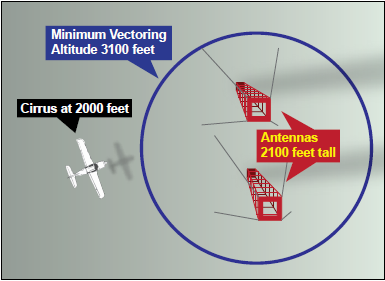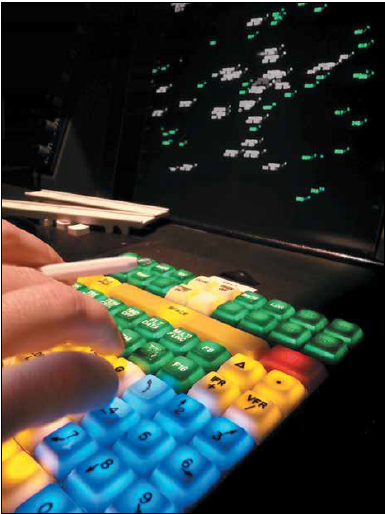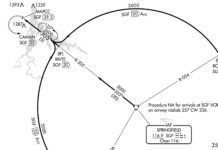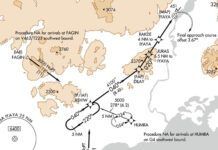During my high school years, I got a lift home from a friend. Approaching my neighborhood, I said, “Turn left here.” I expected my friend to be a sensible driver, spot the clearly marked street a few hundred feet ahead, decelerate, merge into the designated left-turn lane, look for traffic, and smoothly turn into my neighborhood. My buddy did none of those things. He immediately turned hard left, bolting over a grass and concrete median, and wound up stopped perpendicular to oncoming cars. Clutching the forehead I’d banged on the passenger window, I yelled, “Dude, what the…?” “You said turn left!” he shouted back. I was ticked. “Yeah! I did! I thought you’d look before actually doing it, like a normal person!” While neither us nor his car were permanently damaged, it’s a moment that stuck with me, a reminder how important it is to not blindly follow directions. Now, as an air traffic controller, my mission is to issue accurate, safe instructions to my traffic. However, the responsibility is not just my own. The pilots under my oversight should be thinking before following through with all ATC instructions, creating a safe system of checks and balances. What options are available if they catch something questionable?
That Sinking Feeling
Early in my radar training, I was vectoring some airplanes for approaches, and struggling to make sense of the rules and concepts I’d been getting bashed into my mind. That’s when my trainer did the “instructor shift.” You’ve likely experienced it in flight training. Imagine you’re practicing a landing, instructor beside you. While focused on lining up the runway outside, your scan lapses. You don’t see your airspeed’s bottoming out. Out of the corner of your eye, you notice your instructor’s hands slowly reaching for the yoke and throttle, his feet sliding towards the pedals. This triggers mental alarms. What am I doing wrong? That’s what I’ve termed the “instructor shift”: the subtle movements of someone preparing to take action for a student about to royally foul up. Even in my frazzled state, I noticed my trainer straightening up in his chair, his grip shifting on his radio handset trigger. Alarm bells. What did I mess up? “Hey, Approach?” It was the concerned voice of an IFR Cirrus pilot I’d had on a long downwind vector. “How long are you gonna drive me towards these antennas? I’m about to turn on my own here.” Crap! He was at 2000 feet. Distracted by other aircraft, I’d aimed him directly at an antenna farm that rose up to 2100 feet. The minimum vectoring altitude around those spires was 3100 feet, and he was two miles from popping that bubble. My trainer was poised to turn him if I didn’t catch it … which I hadn’t until the guy spoke up. I sheepishly turned the Cirrus away from the obstruction, and got a good talking-to about scanning my aircraft and obstruction avoidance.
Trust but Verify
Sure, my instructor was ready to take over, but the real hero here was the Cirrus pilot. He trusted ATC—aka, me—to give him good vectors for sequence that day. Like a responsible pilot, though, he didn’t just relinquish control and let his situational awareness fade. He remained extremely attentive of his surroundings and saw an imminent threat. What subsequent courses of action are laid out in the regs? Per §91.3(a), “The pilot-in-command of an aircraft is directly responsible for, and is the final authority as to, the operation of that aircraft.” That’s repeated within and reinforced by AIM section 4-4-1.b.: “If ATC issues a clearance that would cause a pilot to deviate from a rule or regulation, or in the pilot’s opinion, would place the aircraft in jeopardy, IT IS THE PILOT’S RESPONSIBILITY TO REQUEST AN AMENDED CLEARANCE.” I’m not shouting. The AIM specifically capitalizes that last bit for a reason. Controllers are human. Mistakes and oversights occasionally happen in towers and radar rooms. Just like pilots, an effective scan usually catches and corrects them quickly. Usually.  Would aiming a Cirrus headfirst at an antenna farm or any other obstruction “place the aircraft in jeopardy”? You bet it would. In response, the pilot in command did exactly what he was supposed to do: “request an amended clearance.” With a hard turn (and a Cirrus at 2000 feet Minimum Vectoring Altitude 3100 feet Antennas 2100 feet tall humbling, hard-earned lesson) I corrected the situation for him. This exemplifies the importance of speaking up. The cockpit resource management concept doesn’t just remain inside the cockpit or the ATC facility. Pilots and controllers are part of a larger team working together to assure safety.
Would aiming a Cirrus headfirst at an antenna farm or any other obstruction “place the aircraft in jeopardy”? You bet it would. In response, the pilot in command did exactly what he was supposed to do: “request an amended clearance.” With a hard turn (and a Cirrus at 2000 feet Minimum Vectoring Altitude 3100 feet Antennas 2100 feet tall humbling, hard-earned lesson) I corrected the situation for him. This exemplifies the importance of speaking up. The cockpit resource management concept doesn’t just remain inside the cockpit or the ATC facility. Pilots and controllers are part of a larger team working together to assure safety.
In the Hot Seat
Okay, let’s say you reach out. What if you get no response? And why would that happen in the first place? A controller might work multiple— sometimes dozens—of frequencies. During early COVID-19 procedures, for instance, many ATC facilities went to minimal staffing to ensure social distancing. Fewer people worked a lot more combined airspace with many more frequencies. Even with the reduced traffic, aircraft still stepped all over each other. It doesn’t stop with radios. As an approach controller, I’ve got voice lines to multiple center sectors, and the control towers under our oversight. When I communicate with a colleague on one of those land lines, his voice sounds in my ear. Meanwhile, aircraft transmissions come out a loudspeaker and may get washed out in a typically loud radar room. Thus was born the phrase, “Say again. I was on the land line.” Then there’s general workload. I might be running approach sequences to multiple airports, working departures, and handling overflights. Throw in some weather, low-time pilots with phraseology difficulties, overlapping frequencies, and land line coordination. Now my attention is being stretched in a thousand different directions, I’m talking fast, and some radio calls can get missed. That Cirrus pilot said, “I’m about to turn on my own here.” What if I hadn’t responded? Could he have turned? In §91.123—Compliance with ATC Clearances and Instructions—it says: “…no pilot in command may deviate from [an ATC] clearance unless an amended clearance is obtained, an emergency exists, or the deviation is in response to a traffic alert and collision avoidance system resolution advisory.” [Emphasis added.] Was that “an emergency”? Common sense suggests taking action for selfpreservation— therefore preventing an emergency—is justified. The regs also allow maneuvers in response to traffic conflicts. I would expect any pilot to exercise his right to maneuver and dodge an obstruction or traffic. Just don’t forget the last part of §91.123: “Each pilot in command who, in an emergency, or in response to a traffic alert and collision avoidance system resolution advisory, deviates from an ATC clearance or instruction shall notify ATC of that deviation as soon as possible.” When possible, you shall tell ATC that you deviated from the previous clearance. What if ATC issues you a possible pilot deviation warning? Remember: all ATC frequencies are recorded. Even if ATC didn’t answer, your unheeded requests are captured (reinforcing the importance of speaking up). If a deviation is filed, investigators will note you tried to do things “the nice way” first.
The Lesser of Two
That scenario involves a fixed obstacle. AIM 4-4-1.b. also addresses ATC clearances that inadvertently “cause a pilot to deviate from a rule or regulation.” Imagine you’re getting VFR flight following at 1500 feet. To avoid traffic, ATC assigns you a 090 heading, directly at a Class Delta airport’s 2500 foot airspace five miles away. The controller gets swamped. Despite efforts to raise him, there’s no response. You’re still on that vector. The airport has a full pattern. Per FAA Order 7110.65 2-1-16.b., Surface Areas, the radar controller must: “Coordinate with the appropriate control tower for transit authorization when you are providing radar traffic advisory service to an aircraft that will enter another facility’s airspace. NOTE−The pilot is not expected to obtain his/her own authorization through each area when in contact with a radar facility.” Normally, that coordination is out of sight to you. However, you’re also required to “see and avoid other aircraft” per §91.113 (b). All that traffic’s getting closer and closer. You’re VFR. Did ATC assign you an altitude restriction? If not, you’re free to climb above the Class Delta. If they did restrict your altitude, what’s next? If you have a second radio, try to contact that Class D control tower. (Make sure you monitor the first frequency.) The tower might already see you. Tell them what’s going on. “We’re not landing here. Approach left us on a vector and they’re not responding to us.” The tower now knows the skinny and can work around you. They can also likely contact the radar controller via land line and tell them they’re watching you. What if you’re unable to raise the tower? Well, the radar controller’s put you in a no-win situation with few choices. Turning or changing altitude might put you in the way of other, unseen aircraft. Passing through the Delta without speaking to the tower might put you in conflict with the pattern traffic you saw. Either one is a calculated risk. Whichever you decide, keep your wits about you. Don’t make a bad situation worse by not seeing the big picture. An old friend of mine was driving along at night, when a squirrel stopped ahead of her, right in the middle of the road. She faced a choice: flatten the critter, or swerve to avoid it. She chose the latter. Off the road she went … and smashed into a tree she hadn’t seen in the dark. She and the squirrel walked away, but her car was totaled. (I apparently attract bad drivers as friends.) The nexus of this whole scenario is a communications failure. Attempt to re-establish contact as soon as possible, and advise ATC of your actions. Insofar as culpability, per 7110.65 2-1-16 .b., controllers from one facility mustn’t allow their aircraft to enter another controller’s airspace without prior coordination. If radar got so swamped he forgot to turn you away, that’s ultimately on his shoulders. Of course, none of this is legal guidance, just observation based on presented facts. The aviation safety chain has many links. Each of them involves a human being with a responsibility to speak up if something feels off. If no one seems to be listening, all you can do is pick the option most likely to keep you safe, and continue reaching out until you get an answer.






Question: in the Stand Your Ground scenario the controller issued “Skyhawk 3AB, go around, and continue straight ahead across the final. When able, join the opposite downwind.” I am trying to figure out how that would execute. The Skyhawk would continue on base and cross the the final, I get that. Doe the “join the opposite downwind” mean the skyhawk should then turn into a downwind in the opposite direction (meaning the runway just got turned)? Or should the skyhawk turn a large 270 to be in downwind on the opposite side (shift from left to right traffic or vice versa)? I would have had to ask for clarification.
Gary, you have the idea correct. I was told this once by Tower and had never heard it before, so I told them I wasn’t sure what they wanted and they changed their instruction to a “Right 360°”. I got more clarification later on the ground. When I was told “Fly Through Final” while on Base I was expected to continue on Base, flying through the Final approach leg of the pattern to get re-vectored back to Final. Apparently, this is more common in military aviation. So the expectation in this example would be as you described – to fly through Final to the other side of the runway and join downwind, but probably not a 270 (unless Tower says to). Since the Skyhawk in the example was left-traffic, once they got to the other side of the runway(s) they would/could just turn right to be on an extended right downwind and probably get cleared to follow with a “caution, wake turbulence”. This past summer while KRNO’s longer 16R/34L ILS runway has been OTS for re-paving we’ve been following the big birds a lot and it has been good training for my students (and me) with lots of 360°s, extended downwinds, and wake turbulence avoidance landings. No more “Fly Through Final”s though…
@Gary- My assumption would be that (assuming I was on left traffic) the controller would want me to join the right downwind. If I made another left, I’d be joining the upwind.
But it is still a little confusing and I’d query the controller if they meant (in this case) right downwind, or upwind and do another left traffic circle around the pattern.